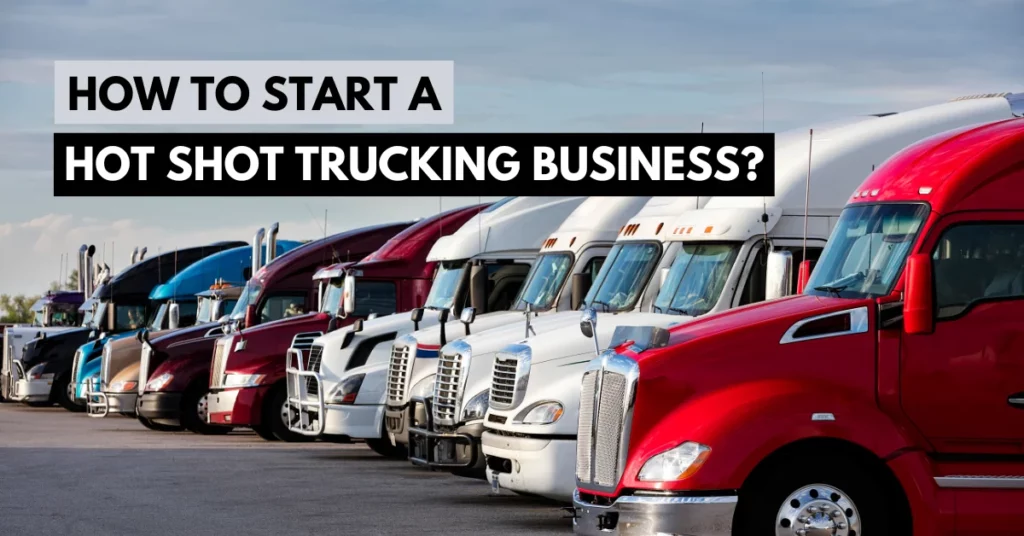How to start a hot shot business? Hotshot trucking has grown in popularity recently as a versatile and successful business within the transportation sector. In this business model, time-sensitive and tiny cargo are transported using a smaller truck to provide speedy and effective delivery services.
This comprehensive blog will coach you through the necessary procedures to put you on the road to success if you’re thinking about launching a hotshot trucking business.
What Is a Hot Shot Business?
A hot shot business is a trucking company that supplies time-sensitive and more minor cargoes with rapid delivery services. Hot shot truckers often use smaller trucks, such as one-ton pickup trucks or medium-duty trucks, along with trailers appropriate for transporting the load. The term “hot shot” comes from the oil and gas business, where timely delivery of equipment and materials is frequently necessary.
On the other hand, hot shot trucking has extended outside the energy sector and currently services multiple companies, including construction, agriculture, and manufacturing. Hotshot enterprises provide speedy, effective, and adaptable transportation options to clients who require immediate delivery of their goods but may not require a full truckload.
Step:1 Conduct Research and Plan
How to start a hot shot trucking business? Research and planning must be done thoroughly before beginning any company enterprise. Think about these crucial elements:
1. Market Analysis
Conduct a thorough market analysis to see whether hot shot trucking services are in demand in your target region. Think about the following elements:
- Industry Trends
Look at the hot shot trucking industry’s predicted expansion and existing trends. Watch for signs of rising demand, including an increase in small businesses seeking accelerated deliveries or the growth of sectors requiring time-sensitive transportation.
- Target Market
Determine which hotshot trucking industry market segment(s) you aim for. Construction, oil and gas, agriculture, and manufacturing are some examples. Recognize their unique transportation requirements and needs so you may adjust your services accordingly.
- Niche Opportunities
Investigate niche opportunities in markets that might have unmet transportation needs. These could include specialized cargo types, specific geographical areas, or sectors with particular needs. Analyze the competition and possible profitability in these niches.
2. Business Plan
Create a thorough business plan outlining your objectives and strategy. Add the following elements:
- Executive Summary
Provide an executive summary of your hotshot trucking company, outlining its mission, goals, and significant differentiators. Describe your company’s ownership, organizational structure, and legal considerations. Describe how your company will distinguish itself from rivals.
- Marketing and Sales Plan
Describe your strategy for marketing and sales. Determine your methods and techniques to connect with potential customers, such as web marketing, networking, joint ventures, or direct sales efforts. Describe your pricing and promotion tactics.
- Operations and Logistics
Describe how your company will manage operations, including driver hiring, dispatching, scheduling, and fleet management. Describe how you intend to guarantee effective and timely deliveries while abiding by rules.
- Financial Projections
Create specific financial forecasts that include startup costs, predicted sales, and estimated spending. Consider car purchase, upkeep, fuel prices, insurance, personnel compensation, and administrative costs. Your profit margins, cash flow, and return on investment should be broken down.
- Risk Evaluation and Emergency Plans
Determine potential threats to the hotshot trucking sector, such as changes in the regulatory environment or fierce competition. Create backup strategies to reduce these risks, and specify how you’ll adjust to shifting market conditions.
How to start a hot shot trucking business? You will have a strong base for starting and expanding your hotshot trucking firm if you undertake an exhaustive market analysis and write a thorough business strategy. These processes will assist you in understanding market trends, selecting the proper clients to target, differentiating your services, and successfully managing your operations and finances.
Step 2: Operational and Legal Requirements
You must comply with the following conditions to lawfully operate a hot shot trucking business:
1. Company Registration
- Choose a Business Name
The name of your hot shot trucking company should be distinctive, memorable, and reflect your corporate identity. To ensure clarity, ensure no other company already uses the chosen name.
- Legal Structure
Determine your company’s legal structure, whether a corporation, LLC, partnership or sole proprietorship. Speak with a lawyer or business counselor to learn each system’s advantages and disadvantages and decide which best meets your needs.
- Publish Your Company
Contact the relevant municipal, state, and federal government authorities to register your business. Get any business licenses and permits necessary, as determined by your location and the local laws that apply to the transportation sector there.
2. Licencing and Permitting
- USDOT Number
To get a USDOT number, contact the U.S. Department of Transportation (USDOT). Commercial cars operating in interstate commerce must have this unique identification.
- Motor Carrier Authority
The Federal Motor Carrier Safety Administration (FMCSA) accepts applications for motor carrier authority. This authority allows you to act as a carrier and move items for pay. The application entails completing the required paperwork, paying the required costs, and providing proof that all safety requirements have been met.
- License for Commercial Vehicles (CDL)
Depending on your truck’s weight and the cargo you intend to transport, you could require a CDL. To find out if a CDL is necessary and the requirements for getting one, contact your local Department of Motor Vehicles (DMV).
3. Insurance Protection
- Liability Insurance
Get liability insurance to shield your company from potential lawsuits and claims from mishaps or property damage. Legal fees, medical expenditures, and home repairs are covered in part by this insurance.
- Cargo Insurance
Invest in cargo insurance to shield the goods you’re shipping against theft or damage while they’re en route. This coverage offers financial protection in robberies, mishaps, accidents, natural catastrophes, or other unanticipated events.
- Commercial Auto Insurance
Securing commercial auto insurance that covers your drivers, vehicles, and third-party liabilities is essential. Bodily injury, property damage, and comprehensive coverage for damage to your cars should all be covered by this policy.
Step 3: Equipment Purchase
The correct equipment investment is essential for a hot-shot trucking company. Think about the following:
1. A Trailer and a Truck
- Truck Selection
Pick a truck that complies with the regulations unique to hotshot hauling. Choose a vehicle that can meet the needs of transporting time-sensitive and lighter items. This vehicle should have enough power, towing capability, and durability. One-ton pickup trucks and medium-duty trucks are standard options.
When choosing a vehicle, consider engine power, payload capacity, fuel efficiency, and towing ability. Find a truck that best meets your company’s needs and budget by researching several truck types and manufacturers.
- Trailer Selection
Choose a caravan appropriate for the kinds of merchandise you intend to deliver. Flatbed trailers, gooseneck trailers, and enclosed trailers are popular choices for hotshot transportation. Think about the following:
- Capacity
- Type
- equipment
2. Safeguarding Tools
- Fire Extinguishers
Install fire extinguishers suitable for commercial vehicles in your truck and trailer. Put them in simple places to get to so emergencies can be handled quickly.
- Reflective safety triangles
Keep them in your car in case of breakdowns or accidents to alert other drivers to your presence. Observe the rules about the quantity and positioning of triangles.
- First Aid Kits
Carry a first aid pack that is fully stocked with the essentials for treating minor wounds or medical crises. Make sure both drivers and passengers can easily reach it.
Step 4: Establishing a Trustworthy Network
For your hot-shot trucking business to succeed and expand, it is essential to establish a solid network of customers, suppliers, and business relationships. To build a trustworthy network, take into account the following tactics:
1. Customer Acquisition
- Determine Your Target Market
In the hotshot trucking sector, determine your target market. Look into areas like construction, oil and gas, agriculture, manufacturing, or specialized freight that commonly need accelerated delivery or time-sensitive shipping.
- Marketing Plan
Create a thorough marketing plan to advertise your services and draw customers. Think about the following strategies:
- Website
Establish a reputable website showcasing your offerings, areas of experience, and contact details. To make it more visible online, optimize it for search engines.
- Industry Events
Trade exhibitions, conferences, and networking gatherings connected to transportation, logistics, or your target sectors should be attended—network with possible customers, suppliers, and business leaders to build relationships and produce leads.
- Referrals
Encourage happy clients to recommend your services to their coworkers and business acquaintances. Introduce a referral program or offer rewards for good recommendations.
- Local Business Relationships
Establish connections with neighborhood businesses that might need hotshot hauling services. Make ties with local construction firms, suppliers, wholesalers, and other enterprises frequently requiring transportation to be delivered on schedule.
2. Load Boards and Goods Brokers
- Freight Brokers
Connect with the goods brokers who serve as the middlemen between shippers and carriers. Do some research on reliable goods brokers in your sector and build relationships with them. Establish your dependability, professionalism, and ability to meet the transportation needs of your clientele.
- Load Boards
Register with respected load boards that link shippers looking for transportation services with carriers. Load boards allow you to look for available loads and get reliable work. DAT, Truckstop.com, and uShip are a few common load board choices.
3. Subcontracting
- Partnering with Established Carriers
To get started and secure a steady business while gaining experience, consider subcontracting with established carriers or freight brokers. By doing so, you can benefit from their current clientele and professional connections while setting your own name and track record.
- Subcontracting Arrangements
Contact goods brokers or carriers to discuss subcontracting opportunities. Clearly states the conditions, fees, and expectations to guarantee successful cooperation.
- Quality Service Delivery
Delivering high-quality services is important while subcontracting to build a solid reputation. Shipments should be delivered on time, with effective communication and care. Direct recommendations and prospective future client ties can result from this.
Step 5: Financial and Operational Management
How much to start a hot shot trucking business? For your hotshot trucking company to succeed and be viable over the long run, efficient operations and sound financial management are crucial. To streamline your business processes and efficiently handle your cash, think about the following strategies:
1. Route Preparation
- Utilize GPS and Mapping Tools
Use GPS devices and sophisticated mapping tools to determine the most effective routes for each delivery. These tools can help you find the fuel-efficient, quickest, and shortest ways, reducing wasted miles and increasing your revenue.
- Consider Traffic and Road Conditions
Keep up-to-date on traffic congestion, road closures, and weather conditions that may affect delivery time. Take into account traffic and road conditions. Use current traffic information and weather notifications to modify your routes and guarantee on-time delivery.
- Consolidate Shipments
Consolidate several shipments with comparable origins and destinations whenever possible to minimize the number of journeys and maximize your load capacity. Effective load consolidation can help you increase profits and cut fuel expenses.
2. Pricing
- Determine Competitive Pricing
Conduct market research and examine your competitors’ pricing tactics. When choosing your pricing structure, keep things like distance, load size, time sensitivity, and market demand in mind. Strive to achieve a balance between profitability and competition.
- Transparent Billing and Invoicing Processes
Establish straightforward and unambiguous billing and invoicing procedures to guarantee prompt client payment. Your payment terms, including due dates and accepted payment options, should be clear. Use internet tools or software that automates invoicing and simplifies the billing process.
- Terms of Payment and Credit Policy
Establish payment conditions that adhere to industry norms while preserving a positive cash flow. Consider imposing a penalty for late payments or providing incentives for early prices. Create a credit policy that defines the requirements for giving customers credit, and do your homework on their creditworthiness.
Last Words
How to start a hotshot business? How much can you earn through a hotshot trucking business? We prepared a detailed guide for you to create your roadmap for starting a hotshot business. Read again if you missed it.
Frequently Asked Questions (FAQs)
Q: Is prior transportation experience required to launch a hotshot business?
A: While past transportation expertise is advantageous, establishing a hot-shot business is optional. On the other hand, having a thorough understanding of the trucking sector and logistics might help you handle the problems more efficiently.
Q: What are the ordinary operating expenses involved with a hot shot business?
A: Fuel expenses, maintenance and repairs, insurance premiums, licensing fees, licenses, taxes, and equipment depreciation can all affect a hotshot business’s operating costs. It is critical to carefully consider these charges and factor them into your financial strategy.
Q: How to start a hot shot business part-time, or does it require a full-time commitment?A: Hot shot businesses can be run part-time or full-time, depending on your goals and availability. Part-time work might provide flexibility, especially if you have other professional obligations. However, remember that in the early phases, creating a customer base and maintaining steady employment may necessitate greater attention and time investment.
Check More:
What Exactly is a Laundromat Business?



